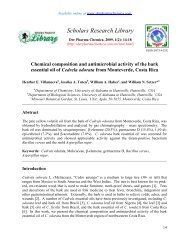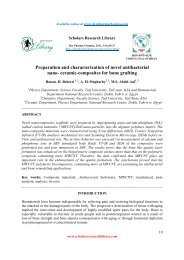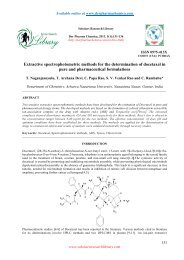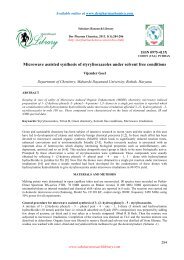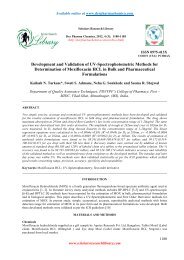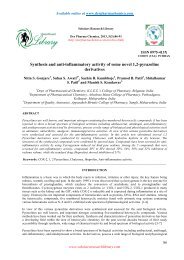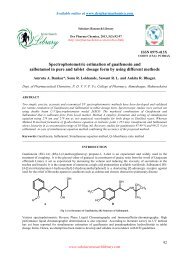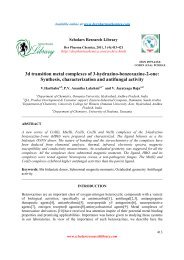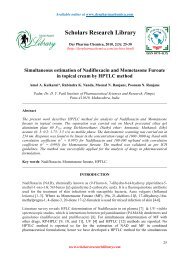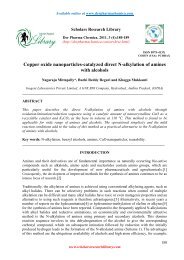Hexamine as corrosion inhibitor for zinc in hydrochloric acid
Hexamine as corrosion inhibitor for zinc in hydrochloric acid
Hexamine as corrosion inhibitor for zinc in hydrochloric acid
You also want an ePaper? Increase the reach of your titles
YUMPU automatically turns print PDFs into web optimized ePapers that Google loves.
Available onl<strong>in</strong>e at www.derpharmachemica.com<br />
Scholars Research Library<br />
Der Pharma Chemica, 2012, 4(5):2117-2123<br />
(http://derpharmachemica.com/archive.html)<br />
<strong>Hexam<strong>in</strong>e</strong> <strong>as</strong> <strong>corrosion</strong> <strong><strong>in</strong>hibitor</strong> <strong>for</strong> <strong>z<strong>in</strong>c</strong> <strong>in</strong> <strong>hydrochloric</strong> <strong>acid</strong><br />
R. T. V<strong>as</strong>hi* and Krunal Desai<br />
www.scholarsresearchlibrary.com<br />
ISSN 0975-413X<br />
CODEN (USA): PCHHAX<br />
*Department of Chemistry, Navyug Science College, Rander Road, Surat, Gujarat, INDIA<br />
_____________________________________________________________________________________________<br />
ABSTRACT<br />
The <strong>corrosion</strong> of <strong>z<strong>in</strong>c</strong> <strong>in</strong> <strong>hydrochloric</strong> <strong>acid</strong> conta<strong>in</strong><strong>in</strong>g hexam<strong>in</strong>e h<strong>as</strong> been studied at different <strong>acid</strong> concentrations,<br />
<strong><strong>in</strong>hibitor</strong> concentration and temperatures. Corrosion <strong>in</strong>cre<strong>as</strong>es with the <strong>in</strong>cre<strong>as</strong>e of <strong>acid</strong> concentration . Inhibition<br />
efficiency (I.E.) of hexam<strong>in</strong>e <strong>in</strong>cre<strong>as</strong>es with the concentration of <strong><strong>in</strong>hibitor</strong> and decre<strong>as</strong>es with the <strong>in</strong>cre<strong>as</strong>e <strong>in</strong><br />
concentration of <strong>acid</strong>. As temperature <strong>in</strong>cre<strong>as</strong>es, <strong>corrosion</strong> rate <strong>in</strong>cre<strong>as</strong>es while percentage of I.E. decre<strong>as</strong>es. The<br />
plot of log (θ/1-θ) versus log C results <strong>in</strong> a straight l<strong>in</strong>e suggest that the <strong><strong>in</strong>hibitor</strong> cover both the anodic and<br />
cathodic regions through general adsorption follow<strong>in</strong>g Langmuir isotherm. Galvenostatic polarization curves show<br />
polarization of both anode <strong>as</strong> well <strong>as</strong> cathode.<br />
Key words: Corrosion, <strong>z<strong>in</strong>c</strong>, <strong>hydrochloric</strong> <strong>acid</strong>, <strong>Hexam<strong>in</strong>e</strong>.<br />
_____________________________________________________________________________________________<br />
INTRODUCTION<br />
Corrosion is a process that occurs when a material deteriorates due to its <strong>in</strong>teraction with the surround<strong>in</strong>g<br />
environment <strong>in</strong> which an electrochemical reaction consumes the material through oxidation [1]. Z<strong>in</strong>c is one of the<br />
most important non-ferrous metals, which f<strong>in</strong>ds extensive use <strong>in</strong> metallic coat<strong>in</strong>g. Z<strong>in</strong>c corrodes <strong>in</strong> solution hav<strong>in</strong>g<br />
pH lower than 6.0 and higher than 12.5, while with<strong>in</strong> this range the <strong>corrosion</strong> is very slow [2]. Hydrochloric <strong>acid</strong> is<br />
highly corrosive, strong m<strong>in</strong>eral <strong>acid</strong> s<strong>in</strong>ce it is completely dissociated <strong>in</strong> water and h<strong>as</strong> major <strong>in</strong>dustrial uses.<br />
Aromatic, aliphatic and heterocyclic am<strong>in</strong>es have been extensively <strong>in</strong>vestigated <strong>as</strong> <strong>corrosion</strong> <strong><strong>in</strong>hibitor</strong>s [3-5].<br />
Accord<strong>in</strong>g to Hackerman et al. [6-7] the <strong>in</strong>hibitive properties of a series of secondary aliphatic and cyclic am<strong>in</strong>es <strong>in</strong><br />
<strong>acid</strong> media are controlled by the percentage of π - orbital of free electron on the nitrogen atom of these compounds.<br />
R.T.V<strong>as</strong>hi et al. [8-9] studied the <strong>corrosion</strong> <strong>in</strong>hibition of <strong>z<strong>in</strong>c</strong> <strong>in</strong> (HNO3+HCl) by ethanolam<strong>in</strong>es and by ethylam<strong>in</strong>es.<br />
R.T.V<strong>as</strong>hi et al. [10] studied <strong>Hexam<strong>in</strong>e</strong> <strong>as</strong> <strong>corrosion</strong> <strong><strong>in</strong>hibitor</strong> of <strong>z<strong>in</strong>c</strong> <strong>in</strong> phosphoric <strong>acid</strong>. In the present work, the<br />
<strong>corrosion</strong> of <strong>z<strong>in</strong>c</strong> by <strong>hydrochloric</strong> <strong>acid</strong> conta<strong>in</strong><strong>in</strong>g hexam<strong>in</strong>e h<strong>as</strong> been reported.<br />
MATERIALS AND METHODS<br />
To study the <strong>corrosion</strong> of <strong>z<strong>in</strong>c</strong> <strong>in</strong> <strong>hydrochloric</strong> <strong>acid</strong>, weight loss method, temperature effect, potential <strong>as</strong> well <strong>as</strong><br />
polarization me<strong>as</strong>urements have been used. Rectangular specimens (4.65 x 2.15 x 0.16 cm) of <strong>z<strong>in</strong>c</strong> hav<strong>in</strong>g an area of<br />
0.2221 dm 2 were taken and cleaned by buff<strong>in</strong>g and immersed <strong>in</strong> 0.01, 0.05, 0.10 and 0.15 M Hydrochloric <strong>acid</strong><br />
concentration with and without <strong><strong>in</strong>hibitor</strong> conta<strong>in</strong><strong>in</strong>g 230 ml test solution at 301 K <strong>for</strong> 24 h immersion period. After<br />
the test, specimens were cleaned by 10% chromic <strong>acid</strong> solution hav<strong>in</strong>g 0.2 % BaCO3 <strong>for</strong> a period of about 2 m<strong>in</strong>utes<br />
[11]. After clean<strong>in</strong>g, test specimens were w<strong>as</strong>hed with distilled water followed by acetone and dried with air drier.<br />
2117
R. T. V<strong>as</strong>hi et al Der Pharma Chemica, 2012, 4 (5):2117-2123<br />
_____________________________________________________________________________<br />
The mean value of weight loss w<strong>as</strong> reported <strong>as</strong> mg/dm 2 shown <strong>in</strong> Table- 1. All chemicals used were of AR grade.<br />
The corrosive solution w<strong>as</strong> prepared <strong>in</strong> double distilled water.<br />
To <strong>as</strong>sess the protective value, hexam<strong>in</strong>e w<strong>as</strong> added <strong>in</strong> 5, 10, 15 and 20 mM concentration <strong>in</strong> 0.01, 0.05, 0.10 and<br />
0.15 M HCl concentration <strong>for</strong> 24 h duration period (Table-1).<br />
To study the effect of temperature on <strong>corrosion</strong> of <strong>z<strong>in</strong>c</strong> <strong>in</strong> 0.05 M HCl, the specimens were immersed <strong>in</strong> 230 ml of<br />
corrosive solution and <strong>corrosion</strong> loss w<strong>as</strong> determ<strong>in</strong>ed at solution temperature of 303, 313, 323 and 333 K <strong>for</strong> an<br />
immersion period of 2 h with and without <strong><strong>in</strong>hibitor</strong>s. From the data I.E., energy of activation (Ea), heat of adsorption<br />
(Qads), free energy of adsorption (ΔGap), change of enthalpy (ΔH) and entropy of adsorption (ΔS) were calculated<br />
and shown <strong>in</strong> Table -2.<br />
For polarization study, metal specimens hav<strong>in</strong>g an area of 0.2221 dm 2 were immersed <strong>in</strong> 230 ml corrosive solution<br />
without and with 20 mM <strong><strong>in</strong>hibitor</strong> concentration <strong>in</strong> 0.01 M HCl. The test cell <strong>in</strong>cludes the metal specimen <strong>as</strong> a<br />
work<strong>in</strong>g electrode, corrosive solution <strong>in</strong> which the specimen w<strong>as</strong> to be tested and saturated calomel electrode (SCE)<br />
<strong>as</strong> a reference electrode <strong>as</strong> well <strong>as</strong> Plat<strong>in</strong>um electrode <strong>as</strong> an auxiliary electrode. The polarization study w<strong>as</strong> made by<br />
us<strong>in</strong>g potentiostat / galvanostat make Gamry, USA with <strong>in</strong>built <strong>corrosion</strong> software. Polarization curves were plotted<br />
with potential aga<strong>in</strong>st log current density (called Tafel plots). Cathodic and anodic polarization curves give cathodic<br />
and anodic Tafel l<strong>in</strong>es correspond<strong>in</strong>gly. The <strong>in</strong>tersect po<strong>in</strong>t of cathodic and anodic Tafel l<strong>in</strong>es gives the <strong>corrosion</strong><br />
current (Icorr) and the <strong>corrosion</strong> potential (Ecorr) [12].<br />
RESULTS AND DISCUSSION<br />
The results are presented <strong>in</strong> Tables 1 to 3 and fig. 1 to 4. To <strong>as</strong>sess the effect of <strong>corrosion</strong> of <strong>z<strong>in</strong>c</strong> <strong>in</strong> <strong>hydrochloric</strong><br />
<strong>acid</strong>, hexam<strong>in</strong>e is added <strong>as</strong> <strong><strong>in</strong>hibitor</strong>.<br />
I.E. h<strong>as</strong> been calculated <strong>as</strong> follows:<br />
I.E. (%) = {(Wu – Wi) / Wu} × 100 ------------- (1)<br />
Where, Wu is the weight loss of metal <strong>in</strong> un<strong>in</strong>hibited <strong>acid</strong> and<br />
Wi is the weight loss of metal <strong>in</strong> <strong>in</strong>hibited <strong>acid</strong>.<br />
Energy of activation (Ea) h<strong>as</strong> been calculated from the slope of log ρ versus 1/T (ρ = <strong>corrosion</strong> rate, T = absolute<br />
temperature) (Fig. 2) and also with the help of the Arrhenius equation [13].<br />
log ( p 2/ p 1)= Ea/ 2.303 R [(1/T1) – (1/T2)] --------------(2)<br />
Where, ρ1 and ρ2 are the <strong>corrosion</strong> rate at temperature T1 and T2 respectively.<br />
The value of heat of adsorption (Qads) w<strong>as</strong> calculated by the follow<strong>in</strong>g equation [14].<br />
Qads = 2.303 R [log ( θ2 / 1 – θ2 ) - log ( θ1 / 1 – θ1 )] x [T1 . T2 / T2 – T1] --------------(3)<br />
where, θ1 and θ2 [θ = (Wu – Wi)/Wi] are the fractions of the metal surface covered by the <strong><strong>in</strong>hibitor</strong> at temperature<br />
T1 and T2 respectively.<br />
The values of the free energy of adsorption (∆Ga) were calculated with the help of the follow<strong>in</strong>g equation [14].<br />
log C = log ( θ / 1 – θ ) – log B ------------- (4)<br />
Where, log B = –1.74 – (ΔGa / 2.303 RT) and C is the <strong><strong>in</strong>hibitor</strong> concentration.<br />
The enthalpy of adsorption (ΔH º a) and entropy of adsorption (ΔS º a) are calculated us<strong>in</strong>g the equation.<br />
www.scholarsresearchlibrary.com<br />
2118
R. T. V<strong>as</strong>hi et al Der Pharma Chemica, 2012, 4 (5):2117-2123<br />
_____________________________________________________________________________<br />
ΔH º a = Ea – RT ------------- (5)<br />
ΔS º a = ΔH -ΔG /T ------------- (6)<br />
Corrosion <strong>in</strong> <strong>acid</strong>: The <strong>corrosion</strong> rate <strong>in</strong>cre<strong>as</strong>es with the <strong>in</strong>cre<strong>as</strong>e <strong>in</strong> concentration of <strong>acid</strong>. The <strong>corrosion</strong> rate w<strong>as</strong><br />
81.98, 1136.48, 3151.05 and 5221.85 mg/dm 2 <strong>in</strong> 0.01, 0.05, 0.10 and 0.15 M HCl concentrations respectively <strong>for</strong> a<br />
period of 24 h at 301 ± 1 K <strong>as</strong> shown <strong>in</strong> Table-1.<br />
Effect of <strong><strong>in</strong>hibitor</strong> concentration: At constant <strong>acid</strong> concentration, the I.E. of the hexam<strong>in</strong>e <strong>in</strong>cre<strong>as</strong>es with the<br />
<strong><strong>in</strong>hibitor</strong> concentration, e.g. <strong>in</strong> c<strong>as</strong>e of <strong>Hexam<strong>in</strong>e</strong> <strong>in</strong> 0.01 M HCl the I.E. w<strong>as</strong> found to be 93.96, 96.16, 97.79 and<br />
97.80 % with respect to 5, 10, 15 and 20 mM <strong><strong>in</strong>hibitor</strong> concentration respectively [Table- 1].<br />
Effect of <strong>acid</strong> concentration: At constant <strong><strong>in</strong>hibitor</strong> concentration, the I.E. decre<strong>as</strong>es with the <strong>in</strong>cre<strong>as</strong>e <strong>in</strong> <strong>acid</strong><br />
concentration. At 20 mM <strong><strong>in</strong>hibitor</strong> concentration, the I.E. of <strong>Hexam<strong>in</strong>e</strong> is 97.80, 97.38, 92.18 and 82.74 % with<br />
respect to 0.01, 0.05, 0.10 and 0.15 M <strong>acid</strong> concentration respectively [Table-1].<br />
Effect of temperature: As the temperature <strong>in</strong>cre<strong>as</strong>es, <strong>corrosion</strong> rate <strong>in</strong>cre<strong>as</strong>es while percentage of I.E. decre<strong>as</strong>es<br />
[Table-2]. Mean ‘Ea’ values were calculated by us<strong>in</strong>g eq.2 <strong>for</strong> <strong>z<strong>in</strong>c</strong> <strong>in</strong> 0.05 M HCl is 29.29 kJmol -1 while <strong>in</strong> <strong>acid</strong><br />
conta<strong>in</strong><strong>in</strong>g <strong><strong>in</strong>hibitor</strong>, the mean Ea value is 93.45 (Table -2). The higher values of mean Ea <strong>in</strong>dicate physical<br />
adsorption of the <strong><strong>in</strong>hibitor</strong> on metal surface [15]. The values of Ea calculated from the slope of Arrhenius plot (Fig.<br />
2 ) and us<strong>in</strong>g eq.2 are almost similar. From Table-2, it is evident that <strong>in</strong> all c<strong>as</strong>es, the Qads values are negative and<br />
rang<strong>in</strong>g from –63.12 to – 68.23 kJmol -1 . The enthalpy change (∆Hºa) is positive (90.85 kJmol -1 ) <strong>in</strong>dicat<strong>in</strong>g the<br />
endothermic nature of the reaction [16] suggest<strong>in</strong>g that higher temperature favours the <strong>corrosion</strong> process. The<br />
entropy (∆Sºa) values are positive (0.39 kJmol -1 ) confirm<strong>in</strong>g that the <strong>corrosion</strong> process is entropically favourable<br />
[17].<br />
Polarization behaviour: Anodic and cathodic galvenostatic polarization curves <strong>for</strong> <strong>z<strong>in</strong>c</strong> <strong>in</strong> 0.01 M HCl <strong>acid</strong>, alone<br />
and conta<strong>in</strong><strong>in</strong>g 20 mM concentration of <strong>Hexam<strong>in</strong>e</strong> is shown <strong>in</strong> Fig. 3 and Fig.4. The curves show polarization of<br />
both, the cathodes <strong>as</strong> well <strong>as</strong> anodes. I.E. calculated from <strong>corrosion</strong> current obta<strong>in</strong>ed by the extrapolation of the<br />
cathodic and anodic Tafel l<strong>in</strong>es are given <strong>in</strong> Table- 3. In almost all the c<strong>as</strong>es, the I.E. from Tafel plots agree well<br />
(with<strong>in</strong> ± 4 %) with the values obta<strong>in</strong>ed from weight loss data.<br />
Mechanism of <strong>corrosion</strong> <strong>in</strong>hibition: Generally, <strong>z<strong>in</strong>c</strong> dissolve <strong>in</strong> <strong>hydrochloric</strong> <strong>acid</strong> solution due to somewhat<br />
hydrogen type of attack, the reaction tak<strong>in</strong>g place at the microelectrodes of the <strong>corrosion</strong> cell be<strong>in</strong>g represented <strong>as</strong>,<br />
Zn -------> Zn +2 + 2e - (anodic reaction) --------------(7)<br />
Reduction reaction is <strong>in</strong>dicated by decre<strong>as</strong>e <strong>in</strong> valence or the consumption of electrodes, <strong>as</strong> shown by the follow<strong>in</strong>g<br />
equation.<br />
2H + + 2e - -------> 2H (ads.) (cathodic reaction) --------------(8)<br />
or H + H3O + + e - -------> H2 ↑ + H2O<br />
The mechanism of <strong><strong>in</strong>hibitor</strong> of <strong>corrosion</strong> is believed to be due to the <strong>for</strong>mation and ma<strong>in</strong>tenance of a protective film<br />
on the metal surface. Further, when log (θ /1-θ) is plotted aga<strong>in</strong>st log C straight l<strong>in</strong>es are obta<strong>in</strong>ed <strong>in</strong> the c<strong>as</strong>e of<br />
hexam<strong>in</strong>e studied (Fig. 1). This suggests that the <strong><strong>in</strong>hibitor</strong> cover both the anodic <strong>as</strong> well <strong>as</strong> cathodic regions through<br />
general adsorption follow<strong>in</strong>g Langmuir isotherm.<br />
<strong>Hexam<strong>in</strong>e</strong> is reported <strong>as</strong> effective <strong>acid</strong> <strong>corrosion</strong> <strong><strong>in</strong>hibitor</strong> <strong>for</strong> various metals [18-22]. Macro molecular size and<br />
higher number of N-atoms of hexam<strong>in</strong>e [22] might have covered almost all active source of <strong>z<strong>in</strong>c</strong>. Four nitrogen atom<br />
of the hexam<strong>in</strong>e hav<strong>in</strong>g high electron density must have functioned <strong>as</strong> the reaction center [23] and the hexam<strong>in</strong>e<br />
molecules might have been chemisorbed to <strong>for</strong>m a th<strong>in</strong> monolayer on the <strong>z<strong>in</strong>c</strong> surface. At lower concentration, it<br />
might have been chemisorbed <strong>in</strong> the flat position and at higher concentration <strong>in</strong> the vertical position [24]. The<br />
<strong><strong>in</strong>hibitor</strong> action can be accounted by the <strong>in</strong>teraction of loan pairs of electrons <strong>in</strong> the nitrogen atom on the positively<br />
www.scholarsresearchlibrary.com<br />
2119
R. T. V<strong>as</strong>hi et al Der Pharma Chemica, 2012, 4 (5):2117-2123<br />
_____________________________________________________________________________<br />
charged metal surface. I. E. The presence of six methylene groups also helps to lead to an enhancement of electron<br />
density at the nitrogen atom, which enhances its adsorption on the metal surface. This <strong>in</strong> turn leads to an <strong>in</strong>cre<strong>as</strong>e <strong>in</strong><br />
the value of I.E [25].<br />
Table – 1 Corrosion rate (CR) and <strong>in</strong>hibition efficiency (I.E.) of <strong>z<strong>in</strong>c</strong> <strong>in</strong> 0.01, 0.05, 0.10 and 0.15 M HCl conta<strong>in</strong><strong>in</strong>g <strong>Hexam<strong>in</strong>e</strong> <strong>as</strong><br />
<strong><strong>in</strong>hibitor</strong>s <strong>for</strong> an immersion period of 24 h at 301 ± 1 K. K.<br />
Acid concentration<br />
System Inhibition 0.01 M 0.05 M 0.10 M 0.15 M<br />
Concentration<br />
CR I.E. CR I.E. CR I.E. CR I.E.<br />
mM mg/dm 2 % mg/dm 2 % mg/dm 2 % mg/dm 2 %<br />
A -- 81.98 - 1136.48 - 3151.05 - 5221.85 -<br />
B 5 4.95 93.96 185.95 83.64 1418.28 54.99 2833.86 45.73<br />
10 3.15 96.16 89.6 92.12 676.72 78.52 1987.84 61.93<br />
15 1.81 97.79 51.33 95.48 327.78 89.6 1022.51 80.42<br />
20 1.8 97.8 29.72 97.38 246.28 92.18 901.39 82.74<br />
A = HCl B = HCl + <strong>Hexam<strong>in</strong>e</strong><br />
Table - 2 Effect of temperature on <strong>corrosion</strong> rate (CR), <strong>in</strong>hibitive efficiency ( I.E %.), energy of activation ( E a ), heat of adsorption<br />
( Qads) and free energy of adsorption ( ΔG°a ) <strong>for</strong> <strong>z<strong>in</strong>c</strong> <strong>in</strong> 0.05 M HCl <strong>acid</strong> conta<strong>in</strong><strong>in</strong>g hexam<strong>in</strong>e.<br />
Inhibitor concentration = 20 mM Immersion period = 2 h Effective area of specimen = 0.2221 dm 2<br />
Temperature (K) Mean from Ea from<br />
303 313 323 333 Ea Eq(1) Arrhenius Qabs<br />
System CR<br />
mg/dm<br />
I.E. CR I.E. CR I.E. CR I.E. Plot 303- 313- 323-<br />
313 323 333<br />
Δ Δ ΔΣα<br />
Γα Ηα<br />
2 % mg/dm 2 % mg/dm 2 % mg/dm 2 % kJ mol -1 kJ mol -1 kJ mol-1 ( Kj mol-1)<br />
A 773.9 - 949.1 - 1594.8 - 2181.1 - 29.2 34.2 - - - - - -<br />
B 4.9 99.3 13.9 98.5 51.8 96.7 139.1 93.6 93.4 95.7 - - - - 90.8 0.39<br />
66.2 68.2 63.1 30.9<br />
A = HCl B = HCl + <strong>Hexam<strong>in</strong>e</strong><br />
System<br />
Table-3 Polarisation data and <strong>in</strong>hibition efficiency (I.E.) of hexam<strong>in</strong>e <strong>for</strong> <strong>z<strong>in</strong>c</strong> <strong>in</strong> 0.01 M HCl at 301 ± 1 K<br />
Inhibitor concentration: 20 mM Effective area of specimen = 0.2221 dm 2<br />
Ecorr<br />
mV<br />
CD<br />
Icorr<br />
mA/cm 2<br />
Tafel slope (mV/decade)<br />
Anodic<br />
Cathodic<br />
B<br />
(mV)<br />
A = HCl B = HCl + <strong>Hexam<strong>in</strong>e</strong><br />
βa = Anodic Tafel constant, βC = Cathodic Tafel constant.<br />
CD = Corrosion current density from <strong>in</strong>terception of anodic and cathodic l<strong>in</strong>es.<br />
www.scholarsresearchlibrary.com<br />
I.E. (%)<br />
By Weightlossmethod By<br />
polarization method<br />
βa -βc<br />
A -1040 0.1190 36.36 277.77 13.96 - -<br />
B -1170 0.0059 111.11 12.30 4.81 98.02 94.05<br />
2120
R. T. V<strong>as</strong>hi et al Der Pharma Chemica, 2012, 4 (5):2117-2123<br />
_____________________________________________________________________________<br />
log (θ /1- θ)<br />
log ρ ( <strong>corrosion</strong> loss, mg/ sq.dm )<br />
1.8<br />
1.6<br />
1.4<br />
1.2<br />
1<br />
0.8<br />
0.6<br />
0.4<br />
0.2<br />
0<br />
3<br />
2.5<br />
2<br />
1.5<br />
1<br />
0.5<br />
0<br />
<strong>Hexam<strong>in</strong>e</strong><br />
-2.3 -2 -1.82 -1.69<br />
Fig. 1 : Plot of log (θ /1- θ) versus log C <strong>for</strong> hexam<strong>in</strong>e <strong>in</strong> 0.05 M <strong>hydrochloric</strong><br />
<strong>Hexam<strong>in</strong>e</strong><br />
<strong>acid</strong> concentration<br />
0 1 2 3 4 5<br />
Fig. 2 : Arrhenius plots <strong>for</strong> <strong>corrosion</strong> of <strong>z<strong>in</strong>c</strong> <strong>in</strong> 0.05M <strong>hydrochloric</strong> <strong>acid</strong> <strong>in</strong><br />
presence of 10 mM <strong><strong>in</strong>hibitor</strong> concentration<br />
www.scholarsresearchlibrary.com<br />
2121
R. T. V<strong>as</strong>hi et al Der Pharma Chemica, 2012, 4 (5):2117-2123<br />
_____________________________________________________________________________<br />
Fig.3: Polarisation curve <strong>for</strong> <strong>corrosion</strong> of <strong>z<strong>in</strong>c</strong> <strong>in</strong> 0.01 M HCl.<br />
Fig.4: Polarisation curve <strong>for</strong> <strong>corrosion</strong> of <strong>z<strong>in</strong>c</strong> <strong>in</strong> 0.01 M HCl conta<strong>in</strong><strong>in</strong>g 20 mM hexam<strong>in</strong>e <strong><strong>in</strong>hibitor</strong>.<br />
www.scholarsresearchlibrary.com<br />
2122
R. T. V<strong>as</strong>hi et al Der Pharma Chemica, 2012, 4 (5):2117-2123<br />
_____________________________________________________________________________<br />
CONCLUSION<br />
� As the <strong>acid</strong> concentration <strong>in</strong>cre<strong>as</strong>e the <strong>corrosion</strong> rate <strong>in</strong>cre<strong>as</strong>es and I.E. of <strong><strong>in</strong>hibitor</strong> decre<strong>as</strong>es.<br />
� As the <strong><strong>in</strong>hibitor</strong> concentration <strong>in</strong>cre<strong>as</strong>es I.E. <strong>in</strong>cre<strong>as</strong>es and <strong>corrosion</strong> rate decre<strong>as</strong>es.<br />
� Addition of <strong><strong>in</strong>hibitor</strong> <strong>in</strong> corrosive media <strong>in</strong>dicates that <strong>as</strong> the temperature <strong>in</strong>cre<strong>as</strong>es <strong>corrosion</strong> rate <strong>in</strong>cre<strong>as</strong>es while<br />
I.E. decre<strong>as</strong>es.<br />
� Galvenostatic polarization curves show polarization of both anode <strong>as</strong> well <strong>as</strong> cathode.<br />
Acknowledgement<br />
The authors are thankful to Department of Chemistry, Navyug Science College, Surat <strong>for</strong> provid<strong>in</strong>g laboratory<br />
facilities.<br />
REFERENCES<br />
[1] G. H. Koch, M. P. H. Brongers, N. G. Thompson, Y. P. Virmani, and J. H. Payer, Corrosion Cost and<br />
Preventive Strategies <strong>in</strong> the United States, CC Technologies Laboratories, Inc., Federal Highway Adm<strong>in</strong>istration,<br />
FHWA-RD-01-XXX, Sept. 2001.<br />
[2] L. L Shreir, Corrosion, George Newnes Ltd., London, 1963, 37<br />
[3] M. Hackerman and J. D. Sudbery, J. Electrochem. Soc., 1950, 97, 109.<br />
[4] V. K. V. Unni and J. C. Ramachar, J. Electrochem. Soc., Japan, 1965, 33, 557.<br />
[5] N. K. Patel, S. S. Sampat, J. C. Vora and R. M. Trivedi, Werkst and Korros., 1970, 10, 809.<br />
[6] N. Hackerman and R. M. Hurd, Proc 1 st Int. Congr. Met. Corros., Butterworths, UK, 1961, 16<br />
[7] N. Hackerman, Annali Uni. Ferrara NS Sez. Suppl, 1961, 3, 99.<br />
[8] R.T.V<strong>as</strong>hi and H.M. Bhajiwala, Der Pharma Chemica, 2010, 2(4), 51-56<br />
[9] R.T. V<strong>as</strong>hi and H.M. Bhajiwala, Bull. Electrochem., 2002 8(6),261-266.<br />
[10] R.T.V<strong>as</strong>hi and Diksha Naik, E-J Chem., 2010, 7(S1), S1-S6.<br />
[11] E. G. Stroud, J. Appl. Chem., 1951, 1, 93.<br />
[12] H. H. Uhlig, Corr. and Corr. Cont., Wiley, USA, 1967, 18.<br />
[13] N. Subramanian and K. Ramakrishnaiah, Ind. J. Tech., 1970, 8, 369.<br />
[14] A.M. S. Abdel and A. E. L. Saied, Trans SAEST, 1981, 16, 197.<br />
[15] I .N. Putilova, V. P. Barannik and S. A. Balez<strong>in</strong>, Metallic <strong>corrosion</strong> Inhibitors, Pergamon Press, Ox<strong>for</strong>d, 1960,<br />
30-32.<br />
[16] D. Agrawal et al., Trans. SAEST, 2003, 38, 111-114.<br />
[17] R. M. Issa, A. Z. El-Sonbati, A. A. El-B<strong>in</strong>dary and H. M. Kera, Eur. Polym. J. 2002, 38, 561.<br />
[18] S. A. Balez<strong>in</strong>, Ann Univ. Ferrerra, Sez., 1966, 5, 277.<br />
[19] K. S. Rajgopalan, C. Rajgopalan, , M. J. Sumderam, Iron and Steel, May 1970.<br />
[20] N. Putilova, Zhur Fis Khim., 1959, 33, 26.<br />
[21] M. N. Desai, G. H. Thanki and H. Mar<strong>in</strong>al<strong>in</strong>i, Anti-Corr. Methods Mater, (1988)15<br />
[22] G. N. Mehta, Bull. Electrochem., 1988, 4 (2) 111<br />
[23] R. C. Ayers and N. Hackerman, J. Electrochem. Soc., 1963, 110, 507.<br />
[24] N. Hackerman, D. D. Justice and E. McCaffrry, Corrosion, 1975, 31(7), 240<br />
[25] V. Violet Dhayabaran, A. Rajendran, J. Rosal<strong>in</strong>e Vimala and A. Anandhakumar, Tans. SAEST, 2005, 40, 134-<br />
138.<br />
www.scholarsresearchlibrary.com<br />
2123
R. T. V<strong>as</strong>hi et al Der Pharma Chemica, 2012, 4 (5):2117-2123<br />
_____________________________________________________________________________<br />
www.scholarsresearchlibrary.com<br />
2125



